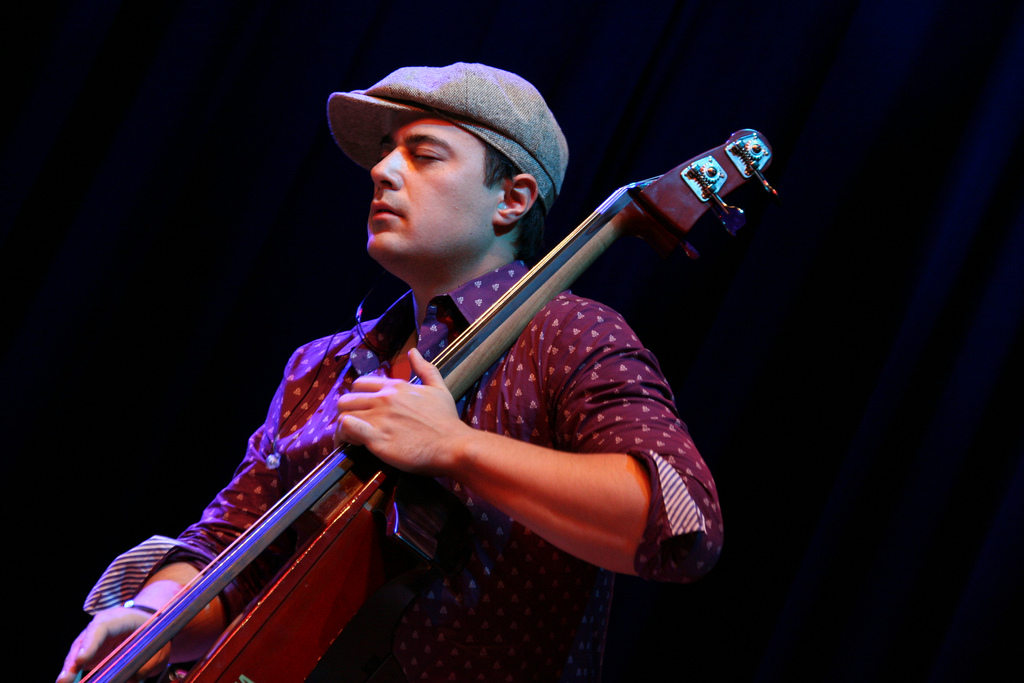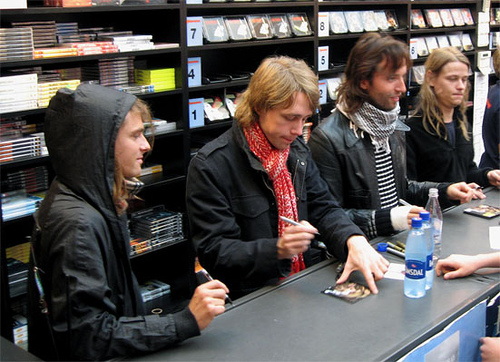|
Music Of Denmark
The earliest traces of Danish music go back to the many twisting Bronze-Age horns or lurs which some experts have identified as musical instruments. They have been discovered in various parts of Scandinavia, mostly Denmark, since the end of the 18th century. Denmark's most famous classical composer is Carl Nielsen, especially remembered for his six symphonies, while the Royal Danish Ballet specializes in the work of Danish choreographer August Bournonville. Danes have distinguished themselves as jazz musicians, and the Copenhagen Jazz Festival has acquired an international reputation. The modern pop and rock scene has produced a few names of note, including MØ, Dizzy Mizz Lizzy, Lukas Graham, D-A-D, Tina Dico, Aqua, The Raveonettes, Michael Learns to Rock, Volbeat, Alphabeat, Safri Duo, Medina, Oh Land, Kashmir, King Diamond, Outlandish, and Mew. Lars Ulrich is the first Danish musician to be inducted into the Rock and Roll Hall of Fame. Origins The earliest traces of Danish m ... [...More Info...] [...Related Items...] OR: [Wikipedia] [Google] [Baidu] |
Medina (singer)
Medina Danielle Oona Valbak (born Andrea Fuentealba Valbak; 30 November 1982), known as Medina (; ), was born in Denmark, and is a Danish singer and songwriter. She currently has released one EP, and seven studio albums. She became popular with various singles such as "Kun for mig" in Scandinavia, and "Addiction" in various European and English-speaking countries. At the 2010 Danish Music Awards, she won female artist of the year, Album of the year, and Songwriter of the year. Career 2007: ''Tæt på'' She released her first two single's in Denmark titled "Flå" ("Rip") and "Et Øjeblik" ("One Moment") in 2007. This was followed by her debut album, ''Tæt på'' (''Close by''). 2008–2010: ''Welcome to Medina'' and rise to fame She rose to fame primarily within several countries in Western Europe in 2008 with the release of "Kun for mig" (which was later released in English as "You and I"), the lead single off her second album, ''Velkommen til Medina'' (''Welcome to Medi ... [...More Info...] [...Related Items...] OR: [Wikipedia] [Google] [Baidu] |
Saxo Grammaticus
Saxo Grammaticus (c. 1150 – c. 1220), also known as Saxo cognomine Longus, was a Danish historian, theologian and author. He is thought to have been a clerk or secretary to Absalon, Archbishop of Lund, the main advisor to Valdemar I of Denmark. He is the author of the ''Gesta Danorum'', the first full history of Denmark, from which the legend of Amleth would come to inspire the story of ''Hamlet'' by Shakespeare. Life The '' Jutland Chronicle'' gives evidence that Saxo was born in Zealand. It is unlikely he was born before 1150 and it is supposed that his death could have occurred around 1220. His name Saxo was a common name in medieval Denmark. The name ''Grammaticus'' ("the learned") was first given to him in the ''Jutland Chronicle'' and the ''Sjælland Chronicle'' makes reference to Saxo ''cognomine Longus'' ("with the byname 'the tall'"). He lived in a period of warfare and Danish expansion, led by Archbishop Absalon and the Valdemars. The Danes were also being threatened ... [...More Info...] [...Related Items...] OR: [Wikipedia] [Google] [Baidu] |
Gesta Danorum
''Gesta Danorum'' ("Deeds of the Danes") is a patriotic work of Danish history, by the 12th-century author Saxo Grammaticus ("Saxo the Literate", literally "the Grammarian"). It is the most ambitious literary undertaking of medieval Denmark and is an essential source for the nation's early history. It is also one of the oldest known written documents about the history of Estonia and Latvia. Consisting of sixteen books written in Latin on the invitation of Archbishop Absalon, ''Gesta Danorum'' describes Danish history and to some degree Scandinavian history in general, from prehistory to the late 12th century. In addition, ''Gesta Danorum'' offers singular reflections on European affairs in the High Middle Ages from a unique Scandinavian perspective, supplementing what has been handed down by historians from Western and Southern Europe. Books The sixteen books, in prose with an occasional excursion into poetry, can be categorized into two parts: Books 1–9, which deal with ... [...More Info...] [...Related Items...] OR: [Wikipedia] [Google] [Baidu] |
Codex Runicus - Drømde Mik En Drøm I Nat
The codex (plural codices ) was the historical ancestor of the modern book. Instead of being composed of sheets of paper, it used sheets of vellum, papyrus, or other materials. The term ''codex'' is often used for ancient manuscript books, with handwritten contents. A codex, much like the modern book, is bound by stacking the pages and securing one set of edges by a variety of methods over the centuries, yet in a form analogous to modern bookbinding. Modern books are divided into paperback or softback and those bound with stiff boards, called hardbacks. Elaborate historical bindings are called treasure bindings. At least in the Western world, the main alternative to the paged codex format for a long document was the continuous scroll, which was the dominant form of document in the ancient world. Some codices are continuously folded like a concertina, in particular the Maya codices and Aztec codices, which are actually long sheets of paper or animal skin folded into pages. Th ... [...More Info...] [...Related Items...] OR: [Wikipedia] [Google] [Baidu] |
Scandinavia
Scandinavia; Sámi languages: /. ( ) is a subregion#Europe, subregion in Northern Europe, with strong historical, cultural, and linguistic ties between its constituent peoples. In English usage, ''Scandinavia'' most commonly refers to Denmark, Norway, and Sweden. It can sometimes also refer more narrowly to the Scandinavian Peninsula (which excludes Denmark but includes part of Finland), or more broadly to include all of Finland, Iceland, and the Faroe Islands. The geography of the region is varied, from the Norwegian fjords in the west and Scandinavian mountains covering parts of Norway and Sweden, to the low and flat areas of Denmark in the south, as well as archipelagos and lakes in the east. Most of the population in the region live in the more temperate southern regions, with the northern parts having long, cold, winters. The region became notable during the Viking Age, when Scandinavian peoples participated in large scale raiding, conquest, colonization and trading mostl ... [...More Info...] [...Related Items...] OR: [Wikipedia] [Google] [Baidu] |
Bronze-Age
The Bronze Age is a historic period, lasting approximately from 3300 BC to 1200 BC, characterized by the use of bronze, the presence of writing in some areas, and other early features of urban civilization. The Bronze Age is the second principal period of the three-age system proposed in 1836 by Christian Jürgensen Thomsen for classifying and studying ancient societies and history. An ancient civilization is deemed to be part of the Bronze Age because it either produced bronze by smelting its own copper and alloying it with tin, arsenic, or other metals, or traded other items for bronze from production areas elsewhere. Bronze is harder and more durable than the other metals available at the time, allowing Bronze Age civilizations to gain a technological advantage. While terrestrial iron is naturally abundant, the higher temperature required for smelting, , in addition to the greater difficulty of working with the metal, placed it out of reach of common use until the end ... [...More Info...] [...Related Items...] OR: [Wikipedia] [Google] [Baidu] |
Rock And Roll Hall Of Fame
The Rock and Roll Hall of Fame (RRHOF), sometimes simply referred to as the Rock Hall, is a museum A museum ( ; plural museums or, rarely, musea) is a building or institution that cares for and displays a collection of artifacts and other objects of artistic, cultural, historical, or scientific importance. Many public museums make thes ... and hall of fame located in downtown Cleveland, Ohio, United States, on the shore of Lake Erie. The museum documents the history of rock music and the artists, producers, engineers, and other notable figures who have influenced its development. The Rock and Roll Hall of Fame Foundation was established on April 20, 1983, by Ahmet Ertegun, founder and chairman of Atlantic Records. After a long search for the right city, Cleveland was chosen in 1986 as the Hall of Fame's permanent home. Architect I. M. Pei designed the new museum, and it was dedicated on September 1, 1995. Rock and Roll Hall of Fame Foundation The RRHOF Foundation was ... [...More Info...] [...Related Items...] OR: [Wikipedia] [Google] [Baidu] |
Lars Ulrich
Lars Ulrich (; ; born 26 December 1963) is a Danish musician best known as the drummer and co-founder of American heavy metal band Metallica. The son and grandson respectively of tennis players Torben and Einer Ulrich, he played tennis in his youth and moved to Los Angeles at age 16 to train professionally. However, rather than playing tennis, Ulrich began playing drums. After publishing an advertisement in ''The Recycler'', Ulrich met James Hetfield and formed Metallica. Along with Hetfield, Ulrich has songwriting credits on almost all of the band's songs, and the two of them are the only remaining original members of the band. Early life Ulrich was born into an upper-middle-class family in Gentofte, Denmark; the son of Lone (''née'' Sylvester-Hvid) and tennis player Torben Ulrich. His paternal grandfather was tennis player Einer Ulrich. His paternal grandmother, Ulla Meyer, was from a Jewish family; as a result, Ulrich's grandfather was persecuted by the Nazis during World ... [...More Info...] [...Related Items...] OR: [Wikipedia] [Google] [Baidu] |
Mew (band)
Mew are a Danish alternative rock band, consisting of Jonas Bjerre (lead vocals), Johan Wohlert (bass) and Silas Utke Graae Jørgensen (drums). Johan Wohlert left the band in 2006 before the birth of his first child, but made a return in 2013 while the band were in the studio, before making his first live appearances since his departure in 2014. Guitarist Bo Madsen left the band in June 2015. This was confirmed in a statement on the band's official website on 1 July of the same year. Whilst their music may be classified as indie and on occasion progressive rock, former guitarist Bo Madsen said "I usually say we are 'indie stadium.' A mix between 'feelings' and 'thinking' is usually good." History Origins (1995–2003) Formed in 1995 in Hellerup, an upper-class suburb of Copenhagen, they had a profound impact on the Danish indie scene, emerging alongside the likes of Carpark North, Swan Lee and Saybia, amongst others, in 2003. They released their debut album ''A Triumph for Man ... [...More Info...] [...Related Items...] OR: [Wikipedia] [Google] [Baidu] |
Outlandish
Outlandish is a hip-hop music group based in Denmark. Formed in 1997, it consisted of Isam Bachiri (born in Denmark and of Berber background), (born in Denmark and of Pakistani background), and (born in Honduras and of Cuban and Honduran descent). All three members are religious, with Isam and Waqas being Muslims and Lenny being Catholic. The group disbanded in 2017 as each member wanted to pursue personal projects. In 2019 band members Waqas and Lenny brought back the band as a duo while Isam continued to pursue a solo career. Outlandish has since released two singles and are currently working on a new album which is set to be released in April 2020. (this needs updating) Career Their first single "Pacific to Pacific" was used in connection with an Amnesty International charity event. Next came the single "Saturday Night", a song that was later included on the soundtrack for the Danish film ''Pizza King''. The lyrics of their song "Look Into My Eyes" are based on a poem by G ... [...More Info...] [...Related Items...] OR: [Wikipedia] [Google] [Baidu] |







